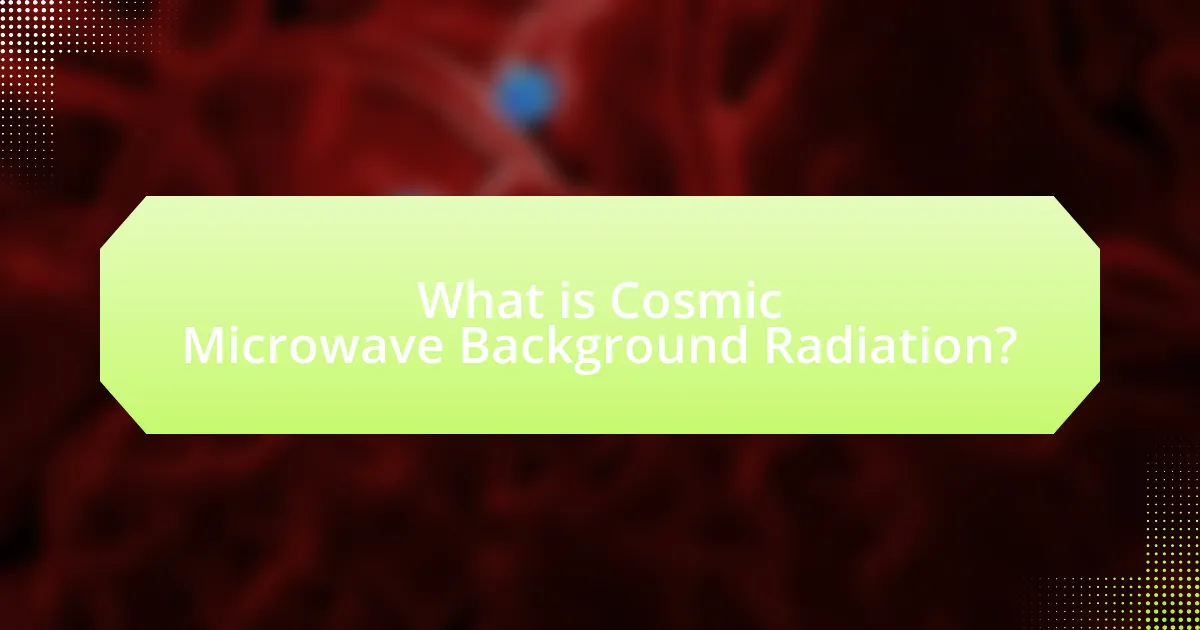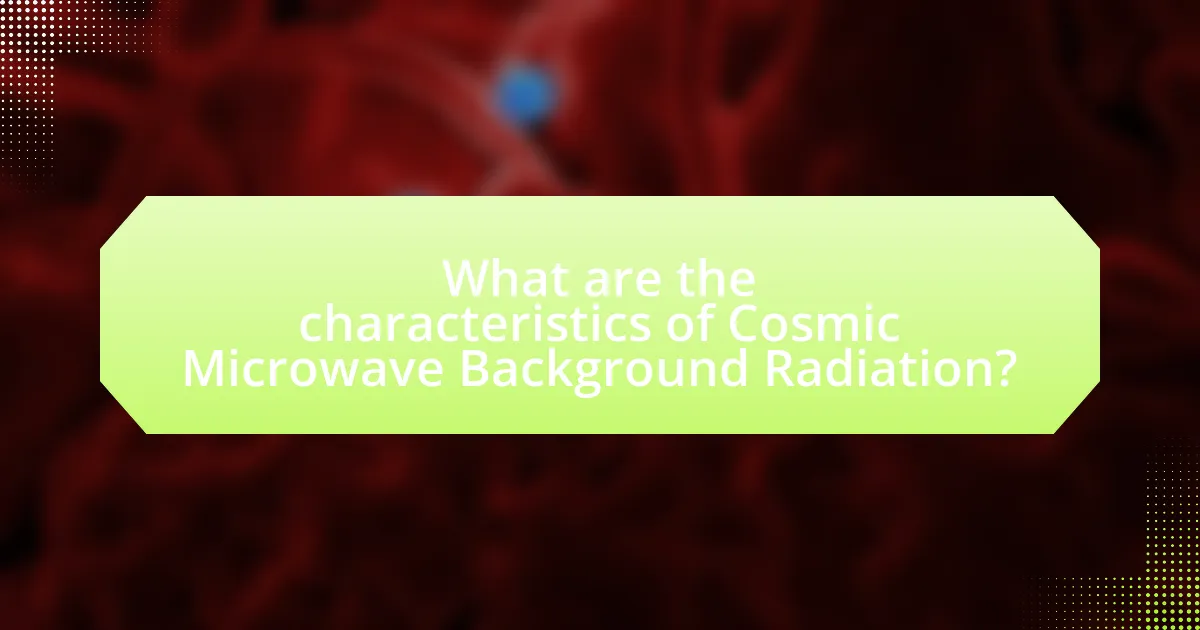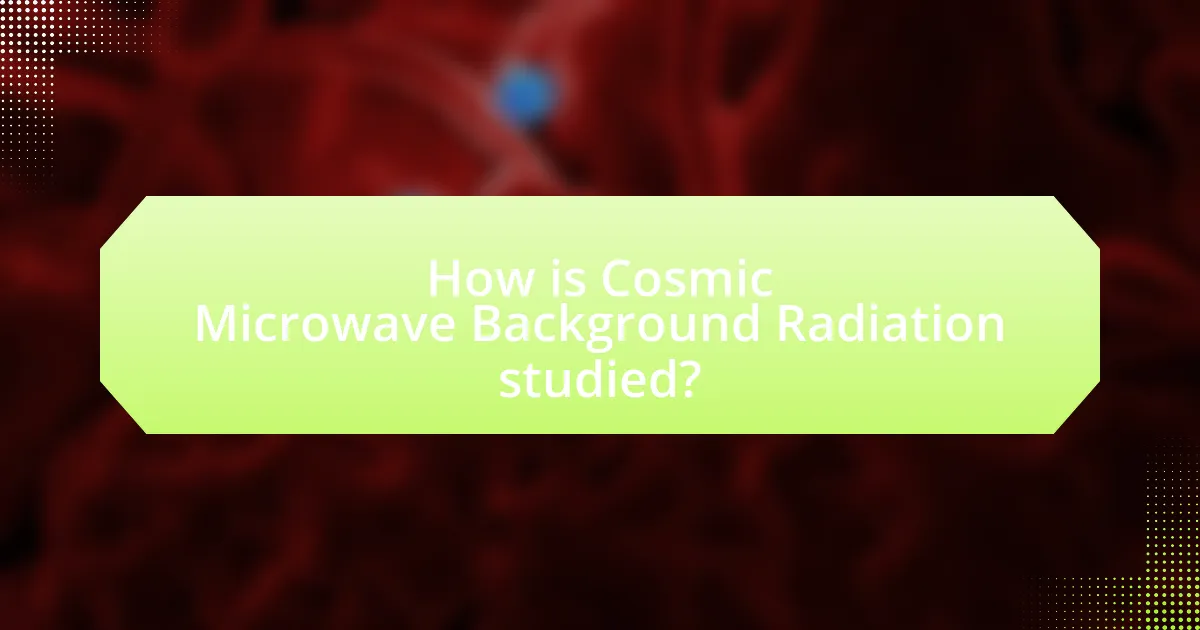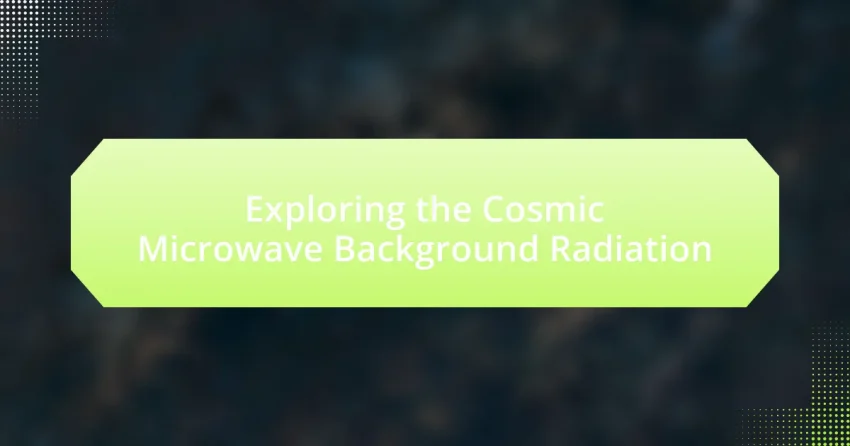Cosmic Microwave Background Radiation (CMB) is the remnant radiation from the Big Bang, providing critical evidence for the universe’s early conditions and supporting the Big Bang theory. Discovered in 1965 by Arno Penzias and Robert Wilson, CMB is characterized by its isotropy and a temperature of approximately 2.7 Kelvin. The article explores the significance of CMB in cosmology, detailing its discovery, key experiments, and the contributions of various scientists. It also discusses the methods used to study CMB, including satellite missions and ground-based observatories, and highlights the implications of CMB research for understanding dark matter, dark energy, and the universe’s evolution.

What is Cosmic Microwave Background Radiation?
Cosmic Microwave Background Radiation (CMB) is the afterglow of the Big Bang, filling the universe with a nearly uniform glow of microwave radiation. This radiation is a remnant from the early universe, specifically from about 380,000 years after the Big Bang when protons and electrons combined to form neutral hydrogen, allowing photons to travel freely. The CMB has a temperature of approximately 2.7 Kelvin and is isotropic, meaning it appears the same in all directions, which supports the theory of an expanding universe. Its discovery in 1965 by Arno Penzias and Robert Wilson provided significant evidence for the Big Bang theory, as the uniformity and spectrum of the CMB match predictions made by cosmological models.
How was Cosmic Microwave Background Radiation discovered?
Cosmic Microwave Background Radiation (CMB) was discovered in 1965 by Arno Penzias and Robert Wilson, who detected a persistent noise in their radio antenna that was isotropic and uniform across the sky. This radiation was identified as the remnant heat from the Big Bang, providing strong evidence for the Big Bang theory. The discovery was significant because it confirmed predictions made by cosmologists, including George Gamow, about the existence of a relic radiation from the early universe. Penzias and Wilson’s findings earned them the Nobel Prize in Physics in 1978, solidifying the CMB’s role as a cornerstone in cosmology.
What key experiments contributed to the discovery of Cosmic Microwave Background Radiation?
The key experiments that contributed to the discovery of Cosmic Microwave Background Radiation (CMBR) include the work of Arno Penzias and Robert Wilson in 1965, who detected a persistent noise in their radio antenna that was isotropic and uniform across the sky. This noise was later identified as the CMBR, providing strong evidence for the Big Bang theory. Their findings were corroborated by the theoretical predictions made by George Gamow and others in the 1940s, who suggested that the universe should be filled with radiation from the early hot state of the cosmos. The significance of Penzias and Wilson’s discovery was recognized when they were awarded the Nobel Prize in Physics in 1978, solidifying the CMBR’s role as a cornerstone of modern cosmology.
Who were the main scientists involved in the discovery?
The main scientists involved in the discovery of the Cosmic Microwave Background Radiation (CMB) are Arno Penzias and Robert Wilson. They conducted experiments in 1965 that led to the accidental discovery of the CMB while working with a radio telescope at Bell Labs. Their findings provided critical evidence for the Big Bang theory, as the CMB is considered a remnant radiation from the early universe. Penzias and Wilson were awarded the Nobel Prize in Physics in 1978 for their work, which confirmed the existence of the CMB and its significance in cosmology.
Why is Cosmic Microwave Background Radiation important in cosmology?
Cosmic Microwave Background Radiation (CMBR) is crucial in cosmology because it provides evidence for the Big Bang theory and offers insights into the early universe’s conditions. The CMBR is the remnant radiation from the hot, dense state of the universe approximately 380,000 years after the Big Bang, when protons and electrons combined to form neutral hydrogen, allowing photons to travel freely. This radiation is uniform and isotropic, with slight fluctuations that correspond to the density variations in the early universe, which later evolved into galaxies and large-scale structures. The precise measurements of the CMBR, particularly from missions like the Wilkinson Microwave Anisotropy Probe (WMAP) and the Planck satellite, have allowed cosmologists to determine key parameters of the universe, such as its age, composition, and rate of expansion, thus solidifying its foundational role in modern cosmology.
What information does Cosmic Microwave Background Radiation provide about the early universe?
Cosmic Microwave Background Radiation (CMBR) provides critical information about the early universe, specifically its temperature, density fluctuations, and the conditions shortly after the Big Bang. The CMBR is a remnant radiation from the hot, dense state of the universe approximately 380,000 years after the Big Bang, revealing a nearly uniform temperature of about 2.7 Kelvin across the sky. This uniformity indicates that the early universe was in a hot, dense state before expanding and cooling.
Furthermore, the slight anisotropies in the CMBR, measured by missions such as the Wilkinson Microwave Anisotropy Probe (WMAP) and the Planck satellite, provide insights into the density fluctuations that led to the formation of large-scale structures like galaxies. These fluctuations are quantified in terms of the power spectrum, which shows how variations in temperature relate to the distribution of matter in the universe. The analysis of the CMBR supports the Big Bang model and helps estimate key cosmological parameters, such as the Hubble constant and the density of dark matter and dark energy.
How does Cosmic Microwave Background Radiation support the Big Bang theory?
Cosmic Microwave Background Radiation (CMB) supports the Big Bang theory by providing evidence of the universe’s hot, dense state shortly after its inception. The CMB is a uniform radiation field detected in all directions, with a temperature of approximately 2.7 Kelvin, which corresponds to the afterglow of the hot plasma that filled the universe when it was about 380,000 years old. This radiation is consistent with predictions made by the Big Bang model, which posits that the universe expanded and cooled over time. The existence of the CMB was confirmed by Arno Penzias and Robert Wilson in 1965, who found it to be isotropic and matching the theoretical blackbody spectrum expected from the early universe, thus validating the Big Bang theory.

What are the characteristics of Cosmic Microwave Background Radiation?
Cosmic Microwave Background Radiation (CMBR) is characterized by its uniformity, isotropy, and blackbody spectrum. It is the remnant radiation from the Big Bang, filling the universe and providing a snapshot of the early cosmos approximately 380,000 years after the event. The CMBR has a temperature of about 2.7 Kelvin, which corresponds to a nearly perfect blackbody spectrum with a peak wavelength in the microwave range. Additionally, the slight fluctuations in temperature, measured at about one part in 100,000, indicate the density variations that led to the formation of large-scale structures in the universe. These characteristics have been confirmed through observations by missions such as the Wilkinson Microwave Anisotropy Probe (WMAP) and the Planck satellite, which provided detailed maps of the CMBR and its anisotropies.
What is the temperature of Cosmic Microwave Background Radiation?
The temperature of Cosmic Microwave Background Radiation is approximately 2.7 Kelvin. This temperature represents the residual thermal radiation from the Big Bang, filling the universe and providing evidence for the hot early state of the cosmos. Measurements from the COBE satellite in 1992 confirmed this temperature, which has been further refined by subsequent missions such as WMAP and Planck, establishing its significance in cosmology.
How does the temperature of Cosmic Microwave Background Radiation relate to the universe’s expansion?
The temperature of Cosmic Microwave Background Radiation (CMBR) is inversely related to the expansion of the universe. As the universe expands, the wavelengths of the radiation stretch, leading to a decrease in temperature. This phenomenon is described by the relationship between temperature and wavelength in blackbody radiation, where the CMBR initially had a temperature of about 3000 Kelvin shortly after the Big Bang and has cooled to approximately 2.7 Kelvin today due to the expansion of space. This cooling is a direct consequence of the universe’s expansion, which has been measured and confirmed through observations of the CMBR by missions such as the Wilkinson Microwave Anisotropy Probe (WMAP) and the Planck satellite.
What variations exist in the temperature of Cosmic Microwave Background Radiation across the sky?
The temperature of Cosmic Microwave Background Radiation (CMBR) varies slightly across the sky, with fluctuations typically around 2.725 K, but with anisotropies ranging from about 2.724 K to 2.726 K. These variations are primarily due to density fluctuations in the early universe, which led to slight differences in temperature as the universe expanded. The Wilkinson Microwave Anisotropy Probe (WMAP) and the Planck satellite have provided detailed maps of these temperature fluctuations, revealing a pattern of hot and cold spots that correspond to the density variations of matter in the early universe.
What is the spectrum of Cosmic Microwave Background Radiation?
The spectrum of Cosmic Microwave Background Radiation (CMBR) is a nearly perfect blackbody spectrum with a temperature of approximately 2.7 Kelvin. This spectrum is characterized by a peak wavelength of about 1.9 millimeters, corresponding to the microwave region of the electromagnetic spectrum. The CMBR is a remnant of the Big Bang, and its blackbody nature supports the theory of an expanding universe, as it shows uniformity in all directions, indicating that it originated from a hot, dense state. The precise measurements of the CMBR spectrum have been confirmed by satellite missions such as the Cosmic Background Explorer (COBE) and the Wilkinson Microwave Anisotropy Probe (WMAP), which have provided strong evidence for the standard model of cosmology.
How does the spectrum of Cosmic Microwave Background Radiation compare to other forms of radiation?
The spectrum of Cosmic Microwave Background Radiation (CMBR) is characterized by a nearly perfect blackbody spectrum with a temperature of approximately 2.7 Kelvin, which distinguishes it from other forms of radiation. This blackbody spectrum indicates that CMBR is the remnant radiation from the Big Bang, filling the universe uniformly and exhibiting a peak wavelength in the microwave range, specifically around 1.9 millimeters. In contrast, other forms of radiation, such as visible light, ultraviolet, and X-rays, have different spectral distributions and peak wavelengths, corresponding to their respective energy levels and sources. For instance, visible light has a peak wavelength around 500 nanometers, while X-rays have much shorter wavelengths, typically in the range of 0.01 to 10 nanometers. The unique characteristics of CMBR’s spectrum provide critical evidence for the Big Bang theory and the evolution of the universe, as it reflects the conditions of the early universe approximately 380,000 years after the Big Bang.
What does the spectrum reveal about the composition of the universe?
The spectrum reveals that the universe is primarily composed of hydrogen and helium, with trace amounts of other elements. Analysis of the cosmic microwave background radiation spectrum shows a nearly uniform distribution of these elements, indicating that they were formed during the Big Bang nucleosynthesis. Specifically, about 75% of the universe’s baryonic matter is hydrogen, while approximately 25% is helium, with less than 1% consisting of heavier elements. This composition is supported by observations from the Planck satellite, which measured the temperature fluctuations in the cosmic microwave background, providing evidence for the elemental makeup of the early universe.

How is Cosmic Microwave Background Radiation studied?
Cosmic Microwave Background Radiation (CMBR) is studied primarily through satellite missions and ground-based observatories that measure its temperature fluctuations and polarization. Instruments like the Wilkinson Microwave Anisotropy Probe (WMAP) and the Planck satellite have provided detailed maps of the CMBR, revealing variations that correspond to the early universe’s density fluctuations. These measurements allow scientists to infer critical cosmological parameters, such as the universe’s age, composition, and expansion rate, with Planck’s data indicating a universe approximately 13.8 billion years old and composed of about 68% dark energy, 27% dark matter, and 5% ordinary matter.
What instruments are used to measure Cosmic Microwave Background Radiation?
Instruments used to measure Cosmic Microwave Background Radiation include the Wilkinson Microwave Anisotropy Probe (WMAP) and the Planck satellite. WMAP, launched in 2001, provided detailed measurements of the temperature fluctuations in the CMB, leading to significant insights into the universe’s age and composition. The Planck satellite, launched in 2009, improved upon WMAP’s findings by offering higher resolution data and more precise measurements of the CMB’s polarization and temperature anisotropies. These instruments have been pivotal in advancing our understanding of the early universe and the Big Bang theory.
How do satellites contribute to the study of Cosmic Microwave Background Radiation?
Satellites contribute to the study of Cosmic Microwave Background Radiation (CMBR) by providing precise measurements of its temperature fluctuations and polarization across the sky. Instruments aboard satellites, such as the Wilkinson Microwave Anisotropy Probe (WMAP) and the Planck satellite, have mapped the CMBR with high sensitivity and resolution, allowing scientists to analyze the early universe’s conditions. These measurements have led to significant insights, including the estimation of the universe’s age at approximately 13.8 billion years and the determination of key cosmological parameters, such as the density of dark matter and dark energy. The data collected by these satellites has been crucial in confirming the Big Bang theory and enhancing our understanding of cosmic evolution.
What role do ground-based observatories play in this research?
Ground-based observatories play a crucial role in the research of Cosmic Microwave Background (CMB) radiation by providing high-resolution measurements and detailed observations of the CMB’s temperature fluctuations. These observatories, equipped with advanced telescopes and detectors, can achieve sensitivity levels that allow scientists to map the CMB with great precision, contributing to our understanding of the universe’s early conditions and its subsequent evolution. For instance, the Atacama Cosmology Telescope and the South Pole Telescope have significantly advanced our knowledge by producing detailed maps of the CMB, which have been instrumental in testing cosmological models and understanding phenomena such as dark energy and the universe’s expansion rate.
What methods are used to analyze Cosmic Microwave Background Radiation data?
The methods used to analyze Cosmic Microwave Background (CMB) Radiation data include statistical analysis, power spectrum estimation, and map-making techniques. Statistical analysis involves examining the temperature fluctuations in the CMB to extract cosmological parameters, while power spectrum estimation quantifies these fluctuations in terms of angular scales, revealing information about the universe’s structure and evolution. Map-making techniques, such as maximum likelihood and Bayesian methods, are employed to create detailed sky maps from raw data collected by satellites like the Wilkinson Microwave Anisotropy Probe (WMAP) and the Planck satellite. These methods have been validated through extensive studies, including the 2018 Planck results, which provided precise measurements of the CMB power spectrum and confirmed the standard model of cosmology.
How do scientists interpret the fluctuations in Cosmic Microwave Background Radiation?
Scientists interpret the fluctuations in Cosmic Microwave Background Radiation (CMBR) as indicators of the early universe’s density variations and temperature differences. These fluctuations, measured by missions like the Wilkinson Microwave Anisotropy Probe (WMAP) and the Planck satellite, reveal the distribution of matter and energy shortly after the Big Bang. The patterns in the CMBR fluctuations correspond to the seeds of cosmic structure formation, providing insights into the universe’s composition, including dark matter and dark energy. Statistical analysis of these fluctuations, such as the power spectrum, allows scientists to derive key cosmological parameters, including the Hubble constant and the curvature of the universe, confirming the Big Bang model and enhancing our understanding of cosmic evolution.
What statistical techniques are employed in the analysis of Cosmic Microwave Background Radiation data?
The statistical techniques employed in the analysis of Cosmic Microwave Background (CMB) Radiation data include power spectrum analysis, Bayesian inference, and Markov Chain Monte Carlo (MCMC) methods. Power spectrum analysis is used to extract the angular power spectrum from the temperature fluctuations in the CMB, which provides insights into the universe’s early conditions. Bayesian inference allows researchers to incorporate prior knowledge and update beliefs based on new data, facilitating parameter estimation related to cosmological models. MCMC methods are utilized to sample from complex posterior distributions, enabling the exploration of parameter spaces efficiently. These techniques are validated through their application in major CMB experiments, such as the Wilkinson Microwave Anisotropy Probe (WMAP) and the Planck satellite, which have produced consistent results supporting the Lambda Cold Dark Matter model of cosmology.
What are the practical implications of studying Cosmic Microwave Background Radiation?
Studying Cosmic Microwave Background Radiation (CMBR) has significant practical implications for understanding the universe’s origins and evolution. CMBR provides critical evidence for the Big Bang theory, allowing scientists to estimate the universe’s age at approximately 13.8 billion years. Additionally, analyzing the temperature fluctuations in CMBR helps researchers understand the distribution of matter and energy in the early universe, which informs models of cosmic structure formation. This understanding aids in the development of advanced technologies, such as improved satellite communication systems and precision measurements in cosmology, as demonstrated by the Planck satellite mission, which has provided detailed maps of the CMBR and refined our knowledge of the universe’s composition.
How does understanding Cosmic Microwave Background Radiation impact our knowledge of dark matter and dark energy?
Understanding Cosmic Microwave Background Radiation (CMBR) enhances our knowledge of dark matter and dark energy by providing critical insights into the early universe’s conditions and structure formation. CMBR measurements, particularly from missions like the Wilkinson Microwave Anisotropy Probe (WMAP) and the Planck satellite, reveal the universe’s temperature fluctuations and density variations, which are influenced by dark matter’s gravitational effects. These fluctuations help cosmologists determine the universe’s composition, indicating that approximately 27% of the universe is dark matter and about 68% is dark energy. The precise measurements of the CMBR’s anisotropies allow scientists to refine models of cosmic inflation and the expansion rate of the universe, linking these phenomena directly to the roles of dark matter and dark energy in cosmic evolution.
What future research directions are being pursued in the study of Cosmic Microwave Background Radiation?
Future research directions in the study of Cosmic Microwave Background Radiation (CMBR) include investigating the polarization of the CMBR to gain insights into the early universe’s conditions and the nature of dark energy. Researchers aim to enhance observational techniques and instruments, such as the upcoming Simons Observatory and the CMB-S4 project, which will provide higher sensitivity and resolution data. These advancements will allow scientists to test inflationary models and explore potential signatures of primordial gravitational waves, thereby deepening our understanding of cosmic evolution and fundamental physics.
What are some common misconceptions about Cosmic Microwave Background Radiation?
Common misconceptions about Cosmic Microwave Background Radiation (CMBR) include the belief that it is a remnant of stars or galaxies, when in fact, it originates from the early universe, specifically from the Big Bang approximately 380,000 years after its occurrence. Another misconception is that CMBR is uniform across the sky; while it is mostly isotropic, there are slight anisotropies that provide critical information about the universe’s structure and evolution. Additionally, some people mistakenly think that CMBR is a form of radiation that can be seen with the naked eye, whereas it is actually in the microwave range of the electromagnetic spectrum, requiring specialized instruments to detect. These misconceptions can lead to misunderstandings about the nature and significance of CMBR in cosmology.
How can these misconceptions affect public understanding of cosmology?
Misconceptions about cosmology can significantly hinder public understanding by fostering confusion and skepticism regarding established scientific principles. For instance, if individuals believe that the universe is static rather than expanding, they may dismiss evidence from the Cosmic Microwave Background Radiation, which supports the Big Bang theory and the universe’s expansion. This misunderstanding can lead to a lack of appreciation for the scientific method and the importance of empirical evidence in cosmology, ultimately resulting in a populace that is less informed about fundamental concepts such as cosmic evolution and the nature of space-time.
What resources are available for further learning about Cosmic Microwave Background Radiation?
Books, online courses, and scientific journals are valuable resources for further learning about Cosmic Microwave Background Radiation. Notable books include “The Cosmic Microwave Background: A New Window on the Universe” by Andrew J. S. Hamilton, which provides a comprehensive overview of the subject. Online platforms like Coursera and edX offer courses on cosmology that cover the Cosmic Microwave Background in detail. Additionally, journals such as “The Astrophysical Journal” and “Physical Review D” frequently publish research articles on advancements related to Cosmic Microwave Background studies, providing current findings and methodologies in the field.
